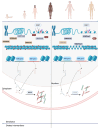The Intersection of Epigenetics and Senolytics in Mechanisms of Aging and Therapeutic Approaches
- PMID: 39858413
- PMCID: PMC11762397
- DOI: 10.3390/biom15010018
The Intersection of Epigenetics and Senolytics in Mechanisms of Aging and Therapeutic Approaches
Abstract
The biological process of aging is influenced by a complex interplay of genetic, environmental, and epigenetic factors. Recent advancements in the fields of epigenetics and senolytics offer promising avenues for understanding and addressing age-related diseases. Epigenetics refers to heritable changes in gene expression without altering the DNA sequence, with mechanisms like DNA methylation, histone modification, and non-coding RNA regulation playing critical roles in aging. Senolytics, a class of drugs targeting and eliminating senescent cells, address the accumulation of dysfunctional cells that contribute to tissue degradation and chronic inflammation through the senescence-associated secretory phenotype. This scoping review examines the intersection of epigenetic mechanisms and senolytic therapies in aging, focusing on their combined potential for therapeutic interventions. Senescent cells display distinct epigenetic signatures, such as DNA hypermethylation and histone modifications, which can be targeted to enhance senolytic efficacy. Epigenetic reprogramming strategies, such as induced pluripotent stem cells, may further complement senolytics by rejuvenating aged cells. Integrating epigenetic modulation with senolytic therapy offers a dual approach to improving healthspan and mitigating age-related pathologies. This narrative review underscores the need for continued research into the molecular mechanisms underlying these interactions and suggests future directions for therapeutic development, including clinical trials, biomarker discovery, and combination therapies that synergistically target aging processes.
Keywords: DNA methylation; aging mechanisms; cellular senescence; epigenetic clock; epigenetics; healthspan extension; senolytics.
Conflict of interest statement
The authors declare no conflicts of interest.
Figures


Similar articles
-
Targeting senescent cells for the treatment of age-associated diseases.J Biochem. 2025 Mar 4;177(3):177-187. doi: 10.1093/jb/mvae091. J Biochem. 2025. PMID: 39727337 Review.
-
A guide to senolytic intervention in neurodegenerative disease.Mech Ageing Dev. 2021 Dec;200:111585. doi: 10.1016/j.mad.2021.111585. Epub 2021 Oct 8. Mech Ageing Dev. 2021. PMID: 34627838 Free PMC article. Review.
-
Targeting Cell Senescence and Senolytics: Novel Interventions for Age-Related Endocrine Dysfunction.Endocr Rev. 2024 Sep 12;45(5):655-675. doi: 10.1210/endrev/bnae010. Endocr Rev. 2024. PMID: 38500373 Free PMC article. Review.
-
Senescence as a therapeutic target in cancer and age-related diseases.Nat Rev Drug Discov. 2025 Jan;24(1):57-71. doi: 10.1038/s41573-024-01074-4. Epub 2024 Nov 15. Nat Rev Drug Discov. 2025. PMID: 39548312 Review.
-
Advances in targeted therapies for age-related osteoarthritis: A comprehensive review of current research.Biomed Pharmacother. 2024 Oct;179:117314. doi: 10.1016/j.biopha.2024.117314. Epub 2024 Aug 20. Biomed Pharmacother. 2024. PMID: 39167845 Review.
Cited by
-
Molecular and Environmental Modulators of Aging: Interplay Between Inflammation, Epigenetics, and RNA Stability.Genes (Basel). 2025 Jul 1;16(7):796. doi: 10.3390/genes16070796. Genes (Basel). 2025. PMID: 40725452 Free PMC article. Review.
-
Targeting Senescence: A Review of Senolytics and Senomorphics in Anti-Aging Interventions.Biomolecules. 2025 Jun 13;15(6):860. doi: 10.3390/biom15060860. Biomolecules. 2025. PMID: 40563501 Free PMC article. Review.
References
Publication types
MeSH terms
Substances
LinkOut - more resources
Full Text Sources
Medical

